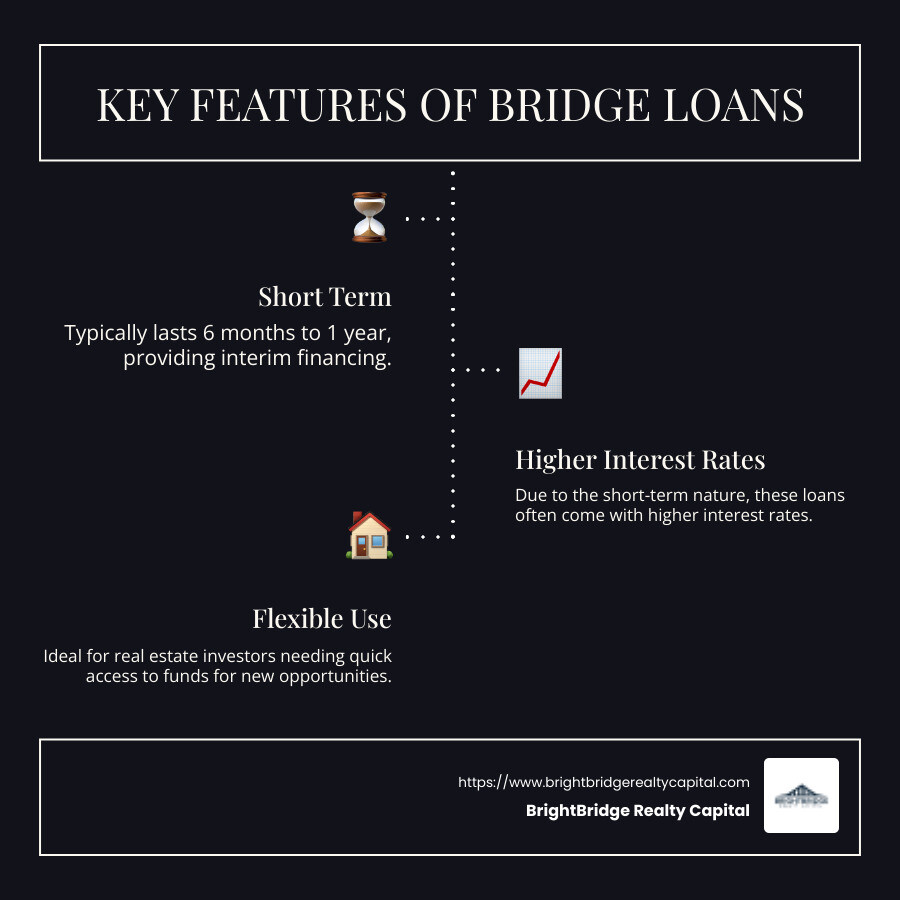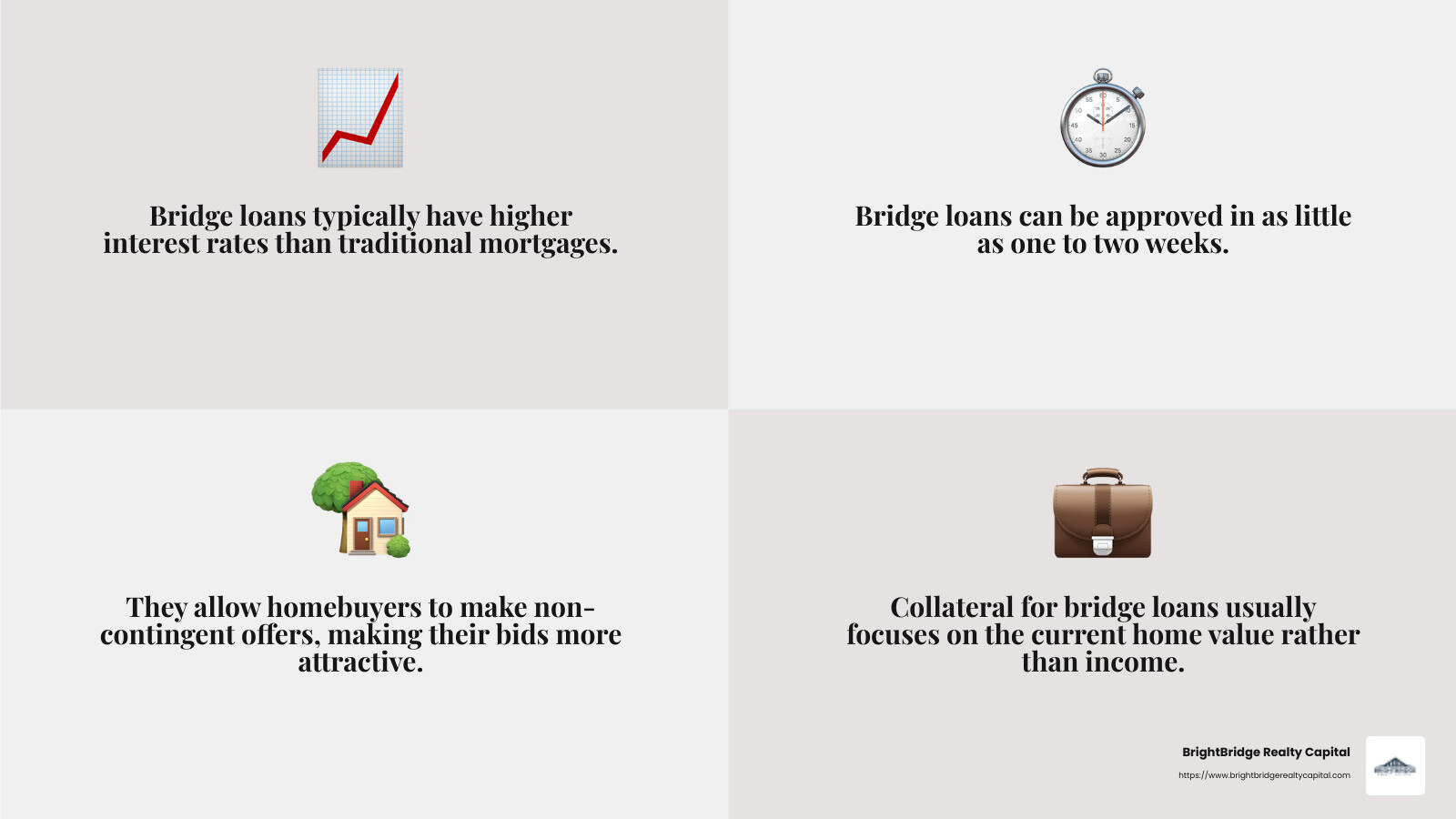Bridge Loans Demystified: A Temporary Financial Solution

Bridge loan definition: A bridge loan is a short-term financing solution that provides immediate cash flow during transitional periods, especially in real estate transactions.
For real estate investors looking to capitalize on new opportunities without the waiting game often associated with traditional loans, bridge loans can be a game-changer. These loans serve as a financial "bridge" when buying a new property while waiting for the sale of an existing one.
Key Points:
- Duration: Typically lasts 6 months to 1 year.
- Purpose: Helps finance a new home or cover expenses while awaiting a property sale.
- Characteristics: Often comes with higher interest rates due to the short-term nature.
- Use Cases: Ideal for investors during transitional phases or quick purchases.
In the world of real estate investing, timing is everything. With bridge loans, investors can swiftly move on fix-and-flip projects or expand rental portfolios without long delays. While these loans offer speed and flexibility, understanding their terms and implications is crucial to making informed decisions.

Bridge Loan Definition: Understanding the Basics
Bridge loans are a short-term loan option designed to provide quick access to funds during transitional periods, particularly in real estate transactions. They help "bridge" the financial gap when you need to buy a new property before selling your current one. This type of financing is often referred to as gap financing.
How Bridge Loans Work
Bridge loans work by using your current property as collateral. This means that your existing home or asset backs the loan, providing security to the lender. Because of this, bridge loans can be approved quickly, often within a couple of weeks, which is much faster than traditional loans.
Interest Rates: Bridge loans usually come with higher interest rates compared to conventional loans. This is because they are short-term and involve more risk for the lender. Rates can range from the prime rate to the prime rate plus 2 percentage points.
Repayment Terms: The repayment term for a bridge loan typically lasts between 6 to 12 months. Some lenders may offer interest-only payments during the loan term, while others might require a balloon payment at the end.
Here's a quick example: If you have a home worth $300,000 with a $50,000 mortgage balance, a bridge loan might allow you to borrow $70,000. You could pay off your existing mortgage and use the remaining funds for a down payment on a new property.
Types of Bridge Loans
Bridge loans come in various forms, each with unique features to suit different needs:
Open Bridging Loan: This type of loan does not have a fixed payoff date. It's flexible but carries higher interest rates due to the uncertainty of repayment. Borrowers who are unsure when their expected financing will come through often choose open bridging loans.
Closed Bridging Loan: In contrast, a closed bridging loan has a predetermined repayment date. This certainty makes it more appealing to lenders, often resulting in lower interest rates. It's typically used when you already have a buyer for your existing property.
First Charge Bridging Loan: This loan gives the lender the first charge over the property. In case of default, the first charge lender gets paid before others. These loans usually have lower interest rates due to reduced risk.
Second Charge Bridging Loan: Here, the lender takes a second charge on the property, meaning they get paid after the first charge lender. Because of the increased risk, these loans come with higher interest rates.
Understanding these different types of bridge loans can help you choose the right one for your situation. Whether you're looking to quickly close on a new property or need temporary funding, knowing how these loans work is key to making smart financial decisions.
Pros and Cons of Bridge Loans
Bridge loans are a powerful tool in real estate, but they're not without their pros and cons. Let's break it down.
Advantages of Bridge Loans
Quick Financing: Bridge loans are designed for speed. They can be approved in as little as one to two weeks, making them ideal for time-sensitive transactions. If you're in a competitive market where homes sell fast, this can be a game-changer.
Fast Approval: Unlike traditional loans that require extensive documentation and time, bridge loans offer fast approval. This is because they focus more on the value of the collateral (your current home) rather than your income or credit history.
Competitive Offers: With a bridge loan, you can make an offer on a new home without a contingency to sell your old one. This makes your offer more attractive to sellers, especially in a hot market where contingent offers are often rejected.
No Contingency: By eliminating the need for a sale contingency, bridge loans allow you to secure your new home first. This is particularly useful if you find your dream home before selling your current property.
Disadvantages of Bridge Loans
Higher Costs: Bridge loans come with higher interest rates compared to traditional mortgages. This is due to the short-term nature and increased risk for lenders. Expect rates to be a few points above the prime rate.

Dual Mortgage Payments: If your old home doesn't sell quickly, you might end up paying two mortgages simultaneously. This can be a significant financial burden and is a risk you should consider before opting for a bridge loan.
Equity Requirements: Most lenders require at least 20% equity in your current home to qualify for a bridge loan. This can be a barrier if you haven't built up enough equity.
Qualification Challenges: While approval is fast, qualifying for a bridge loan can still be challenging. Lenders typically look for a solid credit score and a low debt-to-income ratio. If you have a shaky financial history, you might face problems in securing a bridge loan.
Bridge loans offer a unique blend of advantages and disadvantages. While they provide quick access to funds and competitive offers, the higher costs, dual payments, and qualification problems require careful consideration. As you steer the real estate market, weigh these factors to decide if a bridge loan is the right fit for your financial strategy.
Bridge Loan Definition in Real Estate
Bridge loans are a key player in real estate transactions, especially when buying a new home before selling the old one. They provide a short-term financial solution, bridging the gap between the purchase of a new property and the sale of an existing one.
Bridge Loans vs. Traditional Loans
Home Purchase and Down Payment:
Bridge loans shine when you need to secure a new home but haven't yet sold your current one. They allow you to tap into the equity of your existing home to make a down payment on a new property. This can be particularly useful in competitive markets, where having immediate funds can make your offer more attractive to sellers.
Property Sale:
The main idea behind a bridge loan is to provide temporary financing until your current property sells. Once it's sold, the proceeds are typically used to pay off the bridge loan. This process can help you avoid the pressure of selling your home quickly and potentially at a lower price.
Repayment Timeline:
One of the biggest differences between bridge loans and traditional loans is the repayment timeline. Bridge loans are short-term, usually lasting 6 to 12 months. This is in stark contrast to traditional mortgages, which can stretch up to 30 years. The short timeline means you'll need to have a clear plan for repaying the loan, either through the sale of your current home or obtaining long-term financing.
Loan Processing Speed:
Bridge loans are known for their fast processing speed. They can be approved in as little as one to two weeks, making them ideal for situations where timing is crucial. Traditional loans, on the other hand, often require extensive documentation and can take much longer to process. In a real estate market, this speed can be a significant advantage.
Interest Rates:
Interest rates for bridge loans are typically higher than those for traditional mortgages. This is due to the short-term nature and increased risk for lenders. Rates can range from the prime rate to the prime rate plus a few percentage points. While this might seem steep, the benefits of quick access to funds and the ability to secure a new home without contingencies can outweigh the costs for many buyers.
In summary, bridge loans offer a unique blend of flexibility and speed that can be invaluable in real estate transactions. However, they come with higher interest rates and a shorter repayment timeline. Understanding these differences is crucial in deciding whether a bridge loan is the right fit for your needs.
Frequently Asked Questions about Bridge Loans
What are the typical requirements for a bridge loan?
To qualify for a bridge loan, you'll need to meet certain criteria. Credit score is crucial, with many lenders requiring a score of 740 or higher. Your debt-to-income ratio (DTI) is also important, often needing to be below 50%. Another key factor is home equity. Most lenders require that you have at least 20% equity in your current home to qualify for a bridge loan. This equity acts as collateral, providing security to the lender.
Additionally, some lenders may have other requirements or financial qualifications, so check the specific criteria of the lender you choose.
How do bridge loans differ from hard money loans?
While both bridge loans and hard money loans offer short-term financing, they differ in several ways:
Lending Source: Bridge loans are typically offered by banks or traditional lenders, whereas hard money loans come from private investors or companies.
Risk Level: Hard money loans are considered riskier due to their higher interest rates and less stringent approval processes. They focus more on the property's value than the borrower's financial situation.
Loan Purpose: Bridge loans are mainly used to facilitate real estate transactions, like buying a new home before selling the old one. Hard money loans, on the other hand, are often used for real estate investments, such as property flipping or renovation projects.
Can businesses use bridge loans?
Yes, businesses can also benefit from bridge loans. They serve as a valuable tool for working capital and corporate finance, especially when a company is awaiting longer-term financing. For distressed companies, a bridge loan can provide the necessary funds to stabilize operations until more permanent solutions are in place.
In the business world, bridge loans can help cover expenses like payroll, inventory purchases, or unexpected costs. They offer quick access to cash, allowing businesses to seize opportunities or steer financial gaps without delay.
In conclusion, understanding the requirements and differences of bridge loans can help you decide if they're the right financial tool for your personal or business needs.
Conclusion
At BrightBridge Realty Capital, we understand the importance of quick and flexible financing solutions in the world of real estate. Our customized financing options are designed to meet the unique needs of real estate investors, ensuring that you can seize opportunities as they arise.
Fast closings are our specialty. We often close deals within a week, providing you with the funds you need without the usual hassle and delays. This speed and efficiency are crucial, especially in competitive markets where timing can make all the difference.
By choosing BrightBridge Realty Capital, you're opting for a partner that cuts out the middleman. We offer direct lending with competitive rates, ensuring a seamless process from start to finish. Our expertise in the real estate industry enables us to tailor our services to your specific investment strategy, whether it's flipping, building, or expanding a rental portfolio.
Explore how our bridge loan options can help you bridge the gap in your financial journey. Let us be your trusted partner in navigating the complexities of real estate financing, providing you with the tools and resources to achieve your investment goals.


